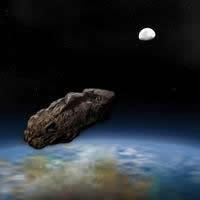Difference between Meteoroid and Meteorite
Key difference: A meteoroid is any debris in the Solar System. When these meteoroids enter the earth’s atmosphere they cause a meteor, i.e. a trail of light, which we refer to as a falling or shooting star. Usually, the meteoroid is small enough that it gets burned up in the process. However, if the meteoroid survives and lands on the surface of the Earth, or parts of it do, they are termed as meteorites.
 A meteoroid is any debris in the Solar System. The size of a meteoroid can range from the size of a grain of sand to a boulder sized particle weighing 220 lbs (100 kgs). The larger meteoroids are often termed as asteroids. The rule of thumb is that anything smaller than a kilometer is termed as a meteoroid, while anything bigger is an asteroid. These meteoroids can come from various sources, such as other planets, their moons, our moon, other asteroids, etc.
A meteoroid is any debris in the Solar System. The size of a meteoroid can range from the size of a grain of sand to a boulder sized particle weighing 220 lbs (100 kgs). The larger meteoroids are often termed as asteroids. The rule of thumb is that anything smaller than a kilometer is termed as a meteoroid, while anything bigger is an asteroid. These meteoroids can come from various sources, such as other planets, their moons, our moon, other asteroids, etc.
When these meteoroids enter the earth’s atmosphere they cause a meteor, i.e. a trail of light, which we refer to as a falling or shooting star. Usually, the meteoroid is small enough that it gets burned up in the process. However, if the meteoroid survives and lands on the surface of the Earth, or parts of it do, they are termed as meteorites.
 A meteorite can be of any size and any weight. The biggest meteorite found in the United States is the Willamette Meteorite. It is 10 feet (3.05 m) tall by 6.5 feet (1.98 m) wide by 4.25 feet (1.3 m) deep, and weighs about 32,000 pounds (14.5 metric tons). The biggest meteorite found on Earth is the Hoba meteorite, which weighs more than 60 tons. It was found and is still located at the Otjozondjupa Region of Namibia. However, there have also been meteorites found on the surface of the moon and Mars. Hence, a meteorite is any interplanetary debris leftover after a meteoroid enters the atmosphere and has impacted on the surface.
A meteorite can be of any size and any weight. The biggest meteorite found in the United States is the Willamette Meteorite. It is 10 feet (3.05 m) tall by 6.5 feet (1.98 m) wide by 4.25 feet (1.3 m) deep, and weighs about 32,000 pounds (14.5 metric tons). The biggest meteorite found on Earth is the Hoba meteorite, which weighs more than 60 tons. It was found and is still located at the Otjozondjupa Region of Namibia. However, there have also been meteorites found on the surface of the moon and Mars. Hence, a meteorite is any interplanetary debris leftover after a meteoroid enters the atmosphere and has impacted on the surface.
Traditionally, meteorites have been divided into three broad categories: stony meteorites, iron meteorites and stony-iron meteorites. Stony meteorites are rocks, mainly composed of silicate minerals, iron meteorites are largely composed of metallic iron-nickel, while stony-iron meteorites contain large amounts of both. However, today meteorites are mainly classified based on their structure, chemical and isotopic composition and mineralogy.
Image Courtesy: meteoriteassociationofgeorgia.org, rosssea.info









Add new comment